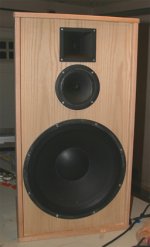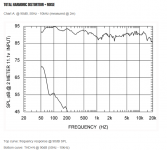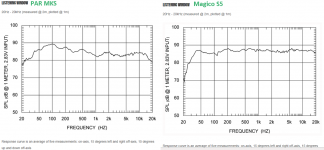I've generally found that wide beamwidth correlates to a 'big' sound.
Correct me if I am wrong, but don't most speakers with cone drivers and dome tweeters have a similar beamwidth?
Correct me if I am wrong, but don't most speakers with cone drivers and dome tweeters have a similar beamwidth?
It's basically a matter of driver size vs. freq.., and it's largely a matter of diffraction over a larger source.
Ex. 12" driver used at 1 kHz is physically wider than a 5" driver used at 1 kHz.
On top of that you will also likely have a larger baffle with the 12" and the bandwidth for the baffle's dominate diffraction is likely to be a little "wider" (over a greater freq. range), and also extend lower in freq..
Still, the easiest way to experiment with this is using a horizontal array: several mid.s horizontally arrayed (..particularly if you are closer to the loudspeakers).
The OP feels like he is clinging onto a rock for dear life as the whitewater of info rushes by, LOL.
It's a "magic" topic.. even many/(most?) commercial designers know less that what has been discussed in this thread so far.
Ok Chris, this is going a little OT...So, which digital xovers would you suggest giving serious consideration to?
Any of the brands mentioned above. I have EV Dx38s (2-In, 4-out) and a Yamaha SP2060 (2-In, 6-Out), and of the two, I like the Yamaha just a little bit more. I purchased all three of these on Craigslist for significantly less than list prices.
I hear good things about EV DC-One (2-in, 6-out) and any of the Ashly loudspeaker processors. All are quality units apparently. Tom Danley recommends other brands that I've not heard.
I hear varying accounts on the SQ of the low cost Behringer (DCX2496), and processor noise problems on the miniDSP that is audible for high efficiency loudspeakers. Same story for the Crown XTi series amplifiers, in addition to poor SQ from the amplifiers themselves. I use XTi-1000s for my two TH-SPUD clone subwoofers--1200 W in strapped Sub mode into the load, in the 17-40 Hz band which is more than sufficient for these subs: these amplifiers provide built-in crossovers and EQ, delay, etc. that makes the job of integrating the subs into my listening space an easy task indeed. Cost is low on the Crown XTi's.
Last edited:
So, which digital xovers would you suggest giving serious consideration to?
These look quite decent but I haven't used either so far:
Ground Sound
dB-Mark Processors
Correct me if I am wrong, but don't most speakers with cone drivers and dome tweeters have a similar beamwidth?
Yes, direct-radiating loudspeakers can sound big due to their wide coverage, but they also suffer from beamwidth narrowing vs. frequency unless multiple drivers are used in "ways" to break up the driver radiating surface designs to match horizontal and vertical coverage of the lower frequency drivers. The extra "ways" with their crossovers create problems, usually in the area of "big" sound degradation. Toole mentions that loudspeakers having changing polar coverage with frequency do poorly in stereo blind listening tests in typical listening rooms. This especially includes dipole loudspeakers.
Direct radiators also suffer from modulation distortion much more than do horn-loaded--categorically speaking. This is the "clean" sounding characteristic of horn-loaded loudspeakers.
Well designed and implemented horn-loaded loudspeakers as a rule sound big but many commercial horn-loaded loudspeaker implementations that I've seen also suffer from either diffraction-related "frying eggs" sound of the older CD midrange horns with hard-edged diffraction slots internally (EV, JBL, etc.), or they suffer from changing polar coverage vs. frequency...especially Le Cléac'h and other non-straight-sided/non-conical horns). This is a statement of the poor implementation practice typically found in horn-loaded circles.
Famously, collapsing polar midrange horns, characteristically seen in the wide but very short-height midrange horn mouths, create their own problems in-room in order to avoid using shelf EQ boost vs. frequency that is predicted by constant coverage horn theory. This is a holdover design practice from the days when active crossovers were expensive, of dubious SQ, and analog-only. I don't recommend these type of midrange horns unless you are prepared to do major acoustic treatment surgery on your room's ceiling and floor in the way of significant ceiling absorption panels and carpets. Having high ceilings (10 feet/3 metres or greater) in your room helps to avoid some of this.
I find that the domain of designing horns really isn't for the casual DIYer unless considerable effort is spent on design simulation (e.g., boundary-element method routines), extensive testing of off-axis polar response of prototypes (usually several trial-and-error design cycles are required), and attention to removing diffraction sources inside the horn profiles that create audible external higher order modes due to internal impedance reflections are the horn's mouth in these types of horns.
I also find that there are but few manufacturers that correct these horn related problems for home hi-fi horn use: most manufacturers typically are used to the PA marketplace that isn't demanding of SQ. Klipsch Professional (i.e., Roy Delgado) is one of the exceptions--among a few others.
Chris
See, this is the ongoing issue with things digital in general, and crossovers/processors in specific.
You "like the sound" of one over the other.
I want stuff that I have a very very difficult time detecting any "sound" at all.
Right now I get that with obsolete passive xovers, shockingly simple ones, since I use unusually good drivers to start with. And, I'm not building a commercial product, so I can do things that might not be a good idea to throw over a wall and have random people buy and use with random gear (if you see the picture here?).
And, fwiw, I'm none too happy with the variations in supposedly nil distortion DACs either... it would be nice if there were far less differentials there.
_-_-
You "like the sound" of one over the other.
I want stuff that I have a very very difficult time detecting any "sound" at all.
Right now I get that with obsolete passive xovers, shockingly simple ones, since I use unusually good drivers to start with. And, I'm not building a commercial product, so I can do things that might not be a good idea to throw over a wall and have random people buy and use with random gear (if you see the picture here?).
And, fwiw, I'm none too happy with the variations in supposedly nil distortion DACs either... it would be nice if there were far less differentials there.
_-_-
I have not heard this but I guess many people would say this speaker sounds big! At least the writer of the review says politely:
"One concern remains: the MKS’s bass. It extends incredibly deep, making this compact floorstander sound at least twice its size, and likely contributes to the vast sense of spaciousness the review samples could provide in my room. But it’s pronounced. If you consider buying a pair, be sure to use an amplifier that can fully control the Polymer’s woofers, and make doubly sure that your room can accommodate the prodigious low-frequency output a pair of MKSes is capable of. My amps and room were good matches for the Polymers -- what I heard didn’t merely impress me, it pushed many of my audiophile hot buttons and positively thrilled me."
Polymer Audio Research MKS SoundStage! Hi-Fi | SoundStageHiFi.com | Polymer Audio Research MKS Loudspeakers
- double bass drivers by SS, MT by Accuton, price 42.000$ pair

And look at response and distortion!
"One concern remains: the MKS’s bass. It extends incredibly deep, making this compact floorstander sound at least twice its size, and likely contributes to the vast sense of spaciousness the review samples could provide in my room. But it’s pronounced. If you consider buying a pair, be sure to use an amplifier that can fully control the Polymer’s woofers, and make doubly sure that your room can accommodate the prodigious low-frequency output a pair of MKSes is capable of. My amps and room were good matches for the Polymers -- what I heard didn’t merely impress me, it pushed many of my audiophile hot buttons and positively thrilled me."
Polymer Audio Research MKS SoundStage! Hi-Fi | SoundStageHiFi.com | Polymer Audio Research MKS Loudspeakers
- double bass drivers by SS, MT by Accuton, price 42.000$ pair

And look at response and distortion!
Attachments
Last edited:
Now when I say "phase" above, I don't just mean it as timing and summing 'upwards' off all the drivers, but also in the peculiar sense of "noise".
Here a small group of us are still arguing about calling it "noise" as it is not random noise - but it will do for now and has already stuck I suspect.
Most people just don't realise how much "phase noise" speakers produce - that the reason that some people like full-range speakers is the lack of any crossover, and they, crossovers, are a huge source of phase noise. Full-range drivers have an advantage, so do headphones, largely because they are single drivers and also because their impedance is higher.
Electrostatic have a huge advantage, at least on paper. They are 'voltage' devices and since amplifiers are also 'voltage' devices, phase noise is much lower.
Dynamic drivers are 'current' devices where the voltage across the voice coil ought to be a function of current 'through' the coil, but are not. So poor tracking of current creates noise since a 'voltage' source can produce current of any phase angle - and that is just a minefield and more so when you put a crossover in between.
I proved this very clearly recently - I acquired a pair of commercial speakers directly from the manufacturer (with who I have a working relationship) and asked several friends to come for a listen. As I already knew the drivers, I then put a totally different crossover in them - very precisely computer modeled and with care to keep voltage and current to track each other much more closely. The aim was to get close to pseudo current drive to suppress phase noise.
I then invited the same persons back. The reaction, even though externally the speakers looked exactly the same as before, this is not the same speaker.
The increase in clarity was immense, before the speakers sounded small and shut in - they now projected a huge soundfield. I might add that the drivers in the box were of very high quality and of the Danish DST school, designed in Denmark and made in China and the quality is of Scan-Speak level. Before that, the quality was totally wasted and now you could hear just how superb they were.
On the same topic, look at the last few years and the latest Dave Wilson designs and note that he says his crossovers are now 'anti-jitter' - and that is indeed just another reference to phase noise. He has his way of dealing with it, we have found our way, which is quite different (and yes, we know how Dave Wilson does it and that our way is a lot more intricate and elegant).
Joe, please accept my apology in advance if I say anything that offends you in what follows.
When I worked at the Tektronix Spectrum Analyzer Business Unit in the mid-Eighties, "phase noise" had a very clearly defined meaning, since it was one the key specifications that set the ultimate performance of the spectrum analyzer.
As we used the term, and as it is used in the RF community, it refers to unwanted FM and PM modulation of a signal that ideally has zero spectral width. On the display, you see a "skirt" of noise that widens the narrow single-frequency signal. It's caused by short-term frequency instability in the tuning oscillators in the instrument, and Tek went to a lot of trouble to make the oscillators as quiet as possible, including mechanical damping and ultra-quiet power supplies. Temperature control (as in TCXO) has no relationship to phase noise; the phase noise we're interested has bandwidths in the 10 Hz to 1 kHz range. Since phase noise limits the ultimate frequency resolution of the instrument, it's a very important specification.
Phase noise is pretty much the same as "jitter" in digital circuits, with the difference that phase noise is never defined with a single-digit number (which would be useless), but a spectral display, typically with a display bandwidth between 1 and 10 kHz wide. If 100/120 Hz power-supply harmonics are visible, the problem is obvious. If ripples at other frequencies are visible, it's usually straightforward to isolate the offending source and remove it. The goal with a spectrum analyzer is to get a single-frequency display as narrow as possible, particularly where the skirt of the single-frequency disappears into the inherent noise floor at the bottom of the display.
I've been designing loudspeakers since 1975, and have never heard "phase noise" or "jitter" in the context of loudspeakers. AM, FM, PM, and IM nonlinear distortion, absolutely. Loudspeakers create lots of nonlinear distortion from many different mechanisms, and choices of crossovers, along with driver design, has a strong effect on these. Whether these nonlinear distortions are audible or not, and at what threshold levels, is a matter for separate discussion.
For a loudspeaker to spectrally widen a single-frequency signal (as in sidebands that are 5 Hz to 100 Hz wide), it would have to have very high levels of IM distortion, as well as spurious 5 to 100 Hz modulation combined with the intended drive signal. This would happen if you played organ-pipe music through a full-range 5" driver, but I can't think of many other scenarios where it could happen. Much of the advantage of a multiway system is a strong reduction of IM distortion of this kind.
Going out on a limb, and jumping off into WAG territory, is there any chance that when you refer to "phase noise" or "jitter" in loudspeakers, it is inter-driver phase angle (in the crossover region)? The phase angle between drivers is audible, and it creates a sense of dislocation and poor integration. My personal threshold for this is very low, around 5 degrees. Other listeners will accept as much as 90 degrees, but I find loudspeakers with this much phase spread across the drivers intolerably phasey-sounding. I became very sensitized to phase spread when developing a quadraphonic decoder, and have not been able to unlearn it.
Or do you refer to overall phase distortion, relative to the incoming electrical signal? Above 1st-order, most crossovers have an allpass phase characteristic, rotating phase 180 or 360 degrees in the octave around the nominal crossover. An allpass characteristic makes a mess out of square waves, but audibility of allpass phase distortion seems to vary depending on frequency and the sensitivity of the listener. (Narrowband group-delay audibility is a separate issue, since narrowband GD variations are frequently the result of internal reflections or diffraction.)
Or do you mean close-in sidebands of IM distortion? The close-in IM sidebands are the result of odd-order harmonic distortion terms (in loudspeakers, mostly 3rd and a little 5th), while the distant IM sidebands are the result of even-order distortion terms (mostly 2nd and a little 4th). In electronics, a common IM test is a 1:1 mix of 14 kHz and 15 kHz. If you see 1 kHz and 29 kHz appear, that's 2nd-order distortion, while the close-in terms are 3rd-order distortion.
As mentioned at the beginning of the post, there's no intention to offend. I've always associated phase noise with various sources of noise in oscillators, and although loudspeakers have unwanted resonances, they're nothing like powered oscillators.
If possible, I'd like to link your usage of the term back to more standard terminology, like IM distortion, AM distortion, FM distortion, PM distortion, phase distortion (relative to incoming signal), inter-driver phase angle in the octave around crossover, reflection, diffraction, etc. etc.
Last edited:
1. This thread is becoming incredibly interesting. I'm learning a ton!
2. You guys are total geeks! (In a good sense of the term!)
I think I must be very sensitive to phase angle as well. I have "heard" that sense of dislocation and phasey-sounding. Even in some mega-buck commercial designs that I thought would sound amazing but was let down.
2. You guys are total geeks! (In a good sense of the term!)
I think I must be very sensitive to phase angle as well. I have "heard" that sense of dislocation and phasey-sounding. Even in some mega-buck commercial designs that I thought would sound amazing but was let down.
Juhazi,
Are we supposed to be impressed by that freq response and distortion plot of the $42k MKS?
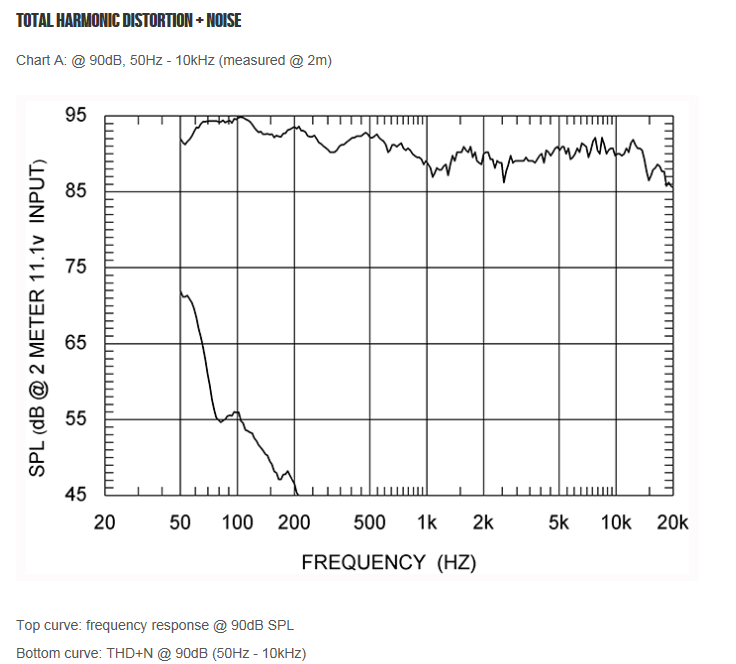
Here are measurements from my Nautaloss ref monitors made using about $80 worth of drivers in a full range plus sub woofer using Vifa tc9fd's and qnty 6 buyout 6.5 inch woofers.
This is at about 95dB levels at 2m away. I get about -40 to -45dB distortion above 200 Hz and -35dB down to 50 Hz. Also spent $130 on two class D amps and a minDSP for active XO. And since they are full range tops the phase is fairly flat/linear from 200 Hz to 20khz so it sounds very good as far as imaging and soundstage goes.
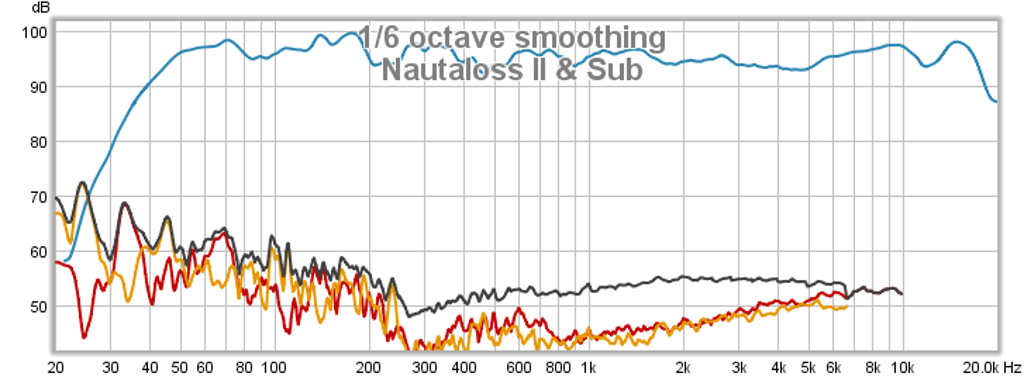
http://www.diyaudio.com/forums/full-range/247598-nautaloss-ref-monitor.html
Are we supposed to be impressed by that freq response and distortion plot of the $42k MKS?

Here are measurements from my Nautaloss ref monitors made using about $80 worth of drivers in a full range plus sub woofer using Vifa tc9fd's and qnty 6 buyout 6.5 inch woofers.
This is at about 95dB levels at 2m away. I get about -40 to -45dB distortion above 200 Hz and -35dB down to 50 Hz. Also spent $130 on two class D amps and a minDSP for active XO. And since they are full range tops the phase is fairly flat/linear from 200 Hz to 20khz so it sounds very good as far as imaging and soundstage goes.

http://www.diyaudio.com/forums/full-range/247598-nautaloss-ref-monitor.html
Last edited:
Or are we supposed to be impressed by $42k?Juhazi,
Are we supposed to be impressed by that freq response and distortion plot of the $42k MKS?
I used to run a disco.
I made my own speakers from 2 cabinets of dual 12 inch Fane 50 watt speakers.
With a 225WRMS amplifier it was very loud.
I later made a couple of cabinets the same but with eminence speakers and they weren't anywhere near as loud.
I guess it is down to the sensitivity of the speakers used.
I made my own speakers from 2 cabinets of dual 12 inch Fane 50 watt speakers.
With a 225WRMS amplifier it was very loud.
I later made a couple of cabinets the same but with eminence speakers and they weren't anywhere near as loud.
I guess it is down to the sensitivity of the speakers used.
Juhazi,
Are we supposed to be impressed by that freq response and distortion plot of the $42k MKS?
It was there to show a correlation of subjective response with objective measurements - that an elevated midrange up to through the upper bass region resulted in a comment of the loudspeaker sounding "at least twice its size".
I agree with that as Cornu's have elevated midbass and sound huge. Just surprised that such expensive speakers were not as low in distortion as I would have expected.
When I first read the review on it (and then looked at the measurements) about a month ago.. I laughed.
Oh well.
Not the topic of this thread though.
I think we have two kinds of "big" sound under discussion. One is a big, open, natural soundstage (the physical space where the performers make music). This can be realized with low-diffraction speakers with good phase transfer between drivers ... and physically, the loudspeaker can be as small as a minimonitor, or very large, although it gets harder to do with spatially dispersed drivers.
The other kind of "big" sound is the ability to render the physical scale of large instruments like concert-grand pianos, a cello, or a complete horn section. If you're familiar with the sound of live, unamplified instruments, you'll find this is beyond the abilities of most direct-radiator audiophile loudspeakers. That's where high-efficiency systems come into their own. Surprisingly, it's not about loudness; a concert grand piano played quietly still sounds large and powerful, and you can sense the physical size of the instrument ... if the playback system is good enough.
Dipoles, although rendering the soundstage beautifully, may get in trouble with instruments with a lot of power in the bass register, as a result of running out of excursion. Electrostats, likewise. It depends a lot on what you listen to, and what you expect from a hifi system.
What about high efficiency speakers makes them better at reproducing large instruments ?
I think I must be very sensitive to phase angle as well. I have "heard" that sense of dislocation and phasey-sounding. Even in some mega-buck commercial designs that I thought would sound amazing but was let down.
Sensitivity to inter-driver phase angle seems to vary widely. Most magazine and website audio-reviewers seem to be totally insensitive to it, since they consistently give glowing reviews to loudspeakers that have very serious crossover problems (based on published measurements, sometimes in the same review). On the other hand, maybe the reviewers are corrupt and don't actually care how the speakers sound, but in the absence of hard evidence one way or the other, there's no way of telling.
By contrast, I'd say it is a safe guess the fullrange, single-driver enthusiasts are very sensitive to inter-driver phase angle, and can't tolerate even small phase deviations between drivers. As mentioned above, my own tolerance is very small, five degrees or less. I can confirm the five-degree tolerance by temporarily inverting phase for the HF driver and measuring the depth of the null in the crossover region. My personal preference is a null of 20 to 25 dB, or better. Working backward, that comes to 0.5 dB or better level-match, and 5 degrees or better phase-match. As a result, the only crossovers I like are acoustical 2nd or 4th-order, which isn't the same as electrical 2nd or 4th-order.
A lot of high-end speakers have pretty miserable crossovers ... which is a complete mystery to me, since Laurie Fincham published the techniques of Target Filter Design back in the Seventies. It was very expensive then, since it required impulse measurements made in an large anechoic chamber, digital averaging over many measurements, FFT processing on a $120,000 DEC minicomputer, and a full-time FORTRAN staff programmer to write (from scratch) the measurement software and crossover optimization algorithms. There were no off-the-shelf solutions back then.
Now all you need is a PC or Mac running Windows, ARTA software or similar, a decent soundcard (true 192/24 ADC/DAC preferred), and a decent microphone. Less than a $1000, all told, and the time to learn how to measure things, understand the measurements, and what they mean. The main investment is time, more than anything else, and these are things you have to learn anyway.
And yet, the majority of $30,000-on-up loudspeakers have pretty poor crossover designs ... things I would have rejected back in 1975, with the primitive 1/3 octave analyzers I had back then. I'll be honest, I just don't get it.
Yes, good crossovers are hard. You have to understand electrical and acoustical addition of phase vectors, the group delay distortion of different topologies, the impact on IM distortion for the HF driver, changes in polar pattern at crossover, the limits you are willing to set on inter-driver phase angles, as well as discovering your own subjective preferences when it comes to 1st-order vs higher-order crossovers, types of drivers, techniques for notch-filtering vs leaving things well alone, etc. etc. This is just paying your dues, and takes several years of failure and partial successes.
But why are we seeing this level of level of ineptitude and don't-care-what-it-sounds-like in commercial speakers sold at very high prices, and maybe worse, with glowing reviews too? What's wrong with the high-end industry?
Last edited:
- Status
- This old topic is closed. If you want to reopen this topic, contact a moderator using the "Report Post" button.
- Home
- Loudspeakers
- Multi-Way
- What gives speakers a "big sound"?
